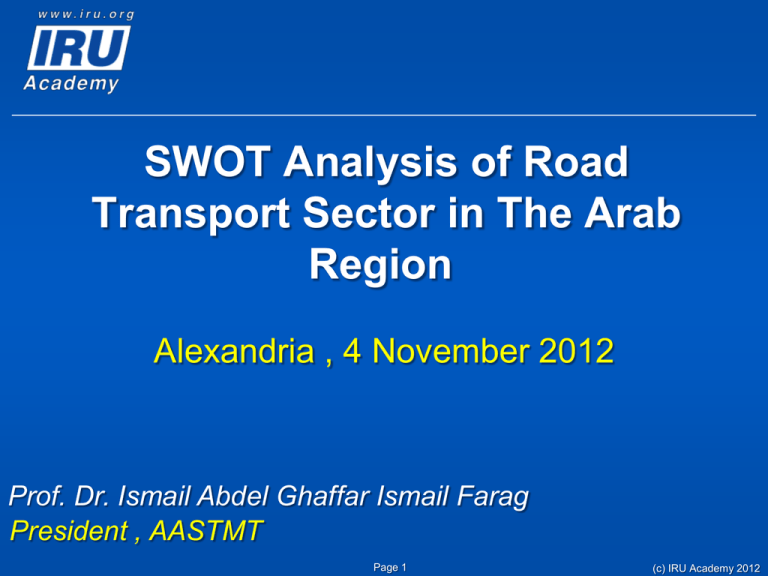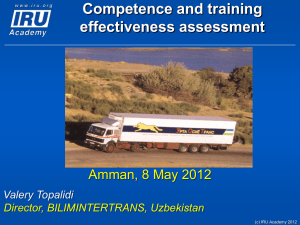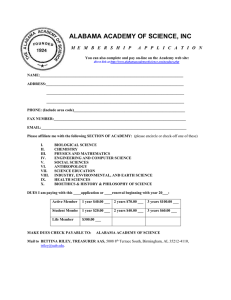Title of Presentation
advertisement

SWOT Analysis of Road Transport Sector in The Arab Region Alexandria , 4 November 2012 Prof. Dr. Ismail Abdel Ghaffar Ismail Farag President , AASTMT Page 1 (c) IRU Academy 2012 Presentation Outline Introduction Regional legislations and agreements Transport for sustainable development in the Arab Region Insights on Roads and Road Transport in EGYPT SWOT Analysis in Arab Region Page 2 (c) IRU Academy 2012 1. Introduction 1.1 Regional Trade: Intra - Arab Trade Total intra-Arab trade witnessed an overall increase over the period 1996-2010, equivalent to around 302%. The increase in the value of trade in transport services is due to the soaring logistics costs in the international arena that are correlated with the price of fuel exports. Page 3 (c) IRU Academy 2012 1.2 National Transport Strategy Develop a comprehensive transport Master Plan inclusive of various transport modes and related infrastructure. Emphasize safety, the integration of environmental considerations, and inter‐modality. Develop a regulatory framework through institutional building and organizational re‐structuring Assess financing strategies with a focus on the participation of the private sector. Strengthen and develop better asset management procedures. Page 4 (c) IRU Academy 2012 1.3 Road Transport Infrastructure and Capacity Utilization Egypt’s road network comprises 91,173 kilometers of roads, divided into 67,728 of main roads and 23,445 kilometers of artery roads. 85% of domestic freight and 60% of passenger movement is carried out by road. By mid-2010, the roads network expanded to 81,932 km of paved roads. There is currently no logistics provider in Egypt with a consistent distribution infrastructure Page 5 (c) IRU Academy 2012 There is also a lack of services around road based transportation. If a network of transit points and connection links were established, an estimated 86 million tons per year (16% of internal freight moved by road) would pass through it. To meet projected usage, Egypt’s roads will require an additional 11.4 million square meters and a total investment of USD 8 billion over the next five to ten years. Page 6 (c) IRU Academy 2012 Major Traits of Transport Infrastructure Page 7 (c) IRU Academy 2012 Logistics Performance Index (LPI) in Arab Countries Page 8 (c) IRU Academy 2012 2. Regional Legislations and Agreements 2.1 Regional Policy Centers on Transport Major transport policy centers in the Arab world include primarily : The UN-ESCWA The Organization of Islamic Conferences The League of Arab States (which created the Council of Arab Ministers of Transport) Page 9 (c) IRU Academy 2012 2.2 UNECE Transport Agreements and Conventions in the Arab World The United Nations Economic Commission for Europe (UNECE) Inland Transport Committee created the framework for intergovernmental cooperation to facilitate international transport along with improving its safety and its environmental performance. The UNECE conventions on transport are concerned with issues of transport infrastructure, road traffic and road signs and signals, road vehicles, legal instruments related to road transport, inland water transport, border crossing facilitation, transit by road, transport of dangerous goods and transport of perishable food stuffs. Page 10 (c) IRU Academy 2012 The Status of the UNECE Transport Agreements and Conventions in the Arab World (2009) Page 11 (c) IRU Academy 2012 The Status of the UNECE Transport Agreements and Conventions in the Arab World )Cont. ) Page 12 (c) IRU Academy 2012 3. Transport for Sustainable Development in the Arab Region: Measures, Progress Achieved, Challenges and Policy Framework Page 13 (c) IRU Academy 2012 Page 14 (c) IRU Academy 2012 4. Insights on Roads and Road Transport in EGYPT Page 15 (c) IRU Academy 2012 4.1 Road Transport Network in Egypt key points within a well-planned and sustainable road transport system: Promoting the use of public transport • Vehicle emissions testing and tuning • Replacing old cars with new ones • ADOPTING ADVANCED TRANSPORT TECHNOLOGIES • Electric vehicles • Page 16 (c) IRU Academy 2012 4.1 Road Transport Network in Egypt ( Cont. ) Roads constitute the dominant means of internal transportation for both passenger and freight operations. Egypt has 52,000 km of paved roads, in addition to a network of bridges. The number of passengers increased as well as cargo transport, reaching 46,288 million tons/km during the year 2007/08. The number of vehicles registered in Egypt has almost doubled over the last ten years, reaching almost 6.6 million in 2005. About 50 per cent of the total vehicles were registered in the Cairo metropolitan area. Page 17 (c) IRU Academy 2012 The Numbers of Licenses Vehicles by Types from 2005 up to end of December 2010 in EGYPT Page 18 (c) IRU Academy 2012 The Numbers of Licenses Vehicles by Types and Governorate up to end of December 2010 in EGYPT: Page 19 (c) IRU Academy 2012 4.2 Operational and Legal Loads of Trucks in Egypt The load on the single front axle calculated by 7 tons • and single rear by 13 tons, that rides 4 rubber tires. The load on the single front axle of the trailer • calculated by 13 tons, that rides the 4 rubber tires. Equivalent load is calculated on the dual narrow axis • by 20 tons and riding on the condition that each axis contains 4 rubber tires that the distance between the axes less than 2 meters. Page 20 (c) IRU Academy 2012 4.2 Operational and Legal Loads of Trucks in Egypt ( Cont. ) Equivalent load is calculated on the wide axis by 13 tons per axle and riding on the condition that each axis contains 4 rubber tires. Equivalent load is calculated on the trio narrow axis • by 30 tons and riding on the condition that each axis has 4 rubber tires. The load of cargo transported could exceed the • range of 5% to overcome the problem of different weights and packaging. Page 21 (c) IRU Academy 2012 4.2 Operational and Legal Loads of Trucks in Egypt ( Cont. ) The length of the vehicle must not exceed the specified lengths: Vehicle with two or more axes is not more than 12 meters. Vehicle with the joint (Simi Trailer) or more is not more than 17 meters in accordance with the new traffic law. Vehicles with a regular trailer no more than 20 meters. The height of the vehicle including the shipment height must not exceed 4 meters from the road surface and the distance between the bottom of the vehicle and the road surface must be 28 cm or more. Page 22 (c) IRU Academy 2012 4.3 Road Sector Strategy Develop, construct and maintain an efficient, safe, well managed network of intercity freeways in order to: Support the rapid pace of economic development by providing access to new development areas (industrial, agriculture, and residential). Accommodate the growth in population and social demands. Prioritize infrastructure projects in view of the above demands. Page 23 (c) IRU Academy 2012 4.4 Reform Policies in the Road Sector Improve design and construction practices through the use of Performance Based Contracts (World Bank project support). Develop an integrated action plan for road safety. (Twining project with the European Union‐ Germany and Austria) Introduce a transparent regulatory process for the issuing of “Transport Operator Licenses” for both freight and passenger, granting access by the Private Sector to the land transport profession. Develop regional border crossing (TIR‐under study), and upgrading the corridors specifications under the UNESCWA agreement. Page 24 (c) IRU Academy 2012 4.5 Twinning Project in Road Safety The project aims at enhancing road safety in Egypt through the reform of road safety planning and operations. It covers areas including: Coordinate National Road Safety Activities Legislative Reforms when applicable Institutional Development and Capacity Building Establish a road safety audit system Improve standards Coordinate information W.R.T. road accident database Page 25 (c) IRU Academy 2012 4.6 Road Infrastructure Investment Egypt raised road construction investments from US$73.3 million in 2003 to about US$366.3 million in 2008. In addition, it raised road maintenance investments from US$36.6 million in 2003 to about US$146.5 million in 2008. Page 26 (c) IRU Academy 2012 4.7 Salaries in Transportation Sector An average worker in the transport sector cannot achieve the average expenditure upon his or her family. The annual salary of a worker in the private transport sector represents just 71% of the average annual income of an Egyptian family living in a city, while it represents 39.3% if the worker is employed in the private sector. The salaries level explains the reason of vast immigration of skilled workforce to other Arabian countries. Page 27 (c) IRU Academy 2012 5. SWOT analysis in Arab Region Page 28 (c) IRU Academy 2012 Strengths High imports/exports rate . Competitive costs . Long road network between major cities and villages High percentage of freight and passengers transported by road Cheap workforce . Positive business climate . Developed road infrastructure . Page 29 (c) IRU Academy 2012 Weaknesses Unprofitable road transport sector Low salaries for the skilled workers Poor road safety record Poor road infrastructure and links Between Arab countries Lack of skilled and trained labor Bad working condition and long working hours No laws and regulations protecting workforce Inadequate implementation mechanism Complexity of laws and regulations or Judicial framework related to road transport Page 30 (c) IRU Academy 2012 Weaknesses( Cont.) Lack of road monitoring (enforcement of road laws and punishment application) Lack of pedestrian regulations Lack of efficient specialized courts Low level of integration with other modes of transport (rail, river, sea) Poor Multimodal Traffic network Corruption High Cost of capital Lack and inaccuracy of industry data Page 31 (c) IRU Academy 2012 Weaknesses( Cont.) Culture of family enterprises Lack of professional management Little openness to outside equity partners Little understanding of global competition Lack of long term financing Insufficient road transport companies (public or private) Lack of co-ordination between road companies and ministry of transport Recruitment of unskilled candidates Page 32 (c) IRU Academy 2012 Weaknesses( Cont.) Lack of road signs (directions, limitations…etc.) Trucks overload Improper loading and lashing Trucks bad technical conditions No counter measure Irregular road maintenance Page 33 (c) IRU Academy 2012 Opportunities Growing national/neighbouring economy Sufficient technical expertise Sufficient knowledge and access to know-how Cheap energy Sufficient environmentally friendly energy supplies (natural gas and scholar energy) Large manpower reservoir Page 34 (c) IRU Academy 2012 Opportunities( Cont.) Well equipped free zones Developed banks’ services Positive business Environment Privatization of enterprises Growth of SMEs Development of private infrastructures Page 35 (c) IRU Academy 2012 Threats Poor economy Unsupportive/combative regime High taxation levels Unstable local and regional political situation Insufficient free trade movements within the Arab and African region No unified Arab or African road regulations No system for transport/logistics operations developments Page 36 (c) IRU Academy 2012 Threats( Cont. ) No liberalisation of trade (some treaties not activated) Inadequate institutional and regulatory frames Insufficient funding Unemployment and social unrest Lack of transparency and corporate governance Page 37 (c) IRU Academy 2012 Threats( Cont. ) Delays in implementation of necessary infrastructures Recent increase in crime rates Increased number of permanent disabilities that reduce productivity (productive age groups) Increased social spending on repair rather than improvement and development Lack of data base and analysis of accident reporting (road crash database). Lack of school and parents education to create the awareness of traffic safety rules and importance. Poor emergency call system. Page 38 (c) IRU Academy 2012 Priority Training Needs Which Might Arise from the SWOT: To up skill existing workforce To train young nationals (Male/female) To recognise needs for additional training To organise training at lower levels Page 39 (c) IRU Academy 2012 Page 40 (c) IRU Academy 2012






